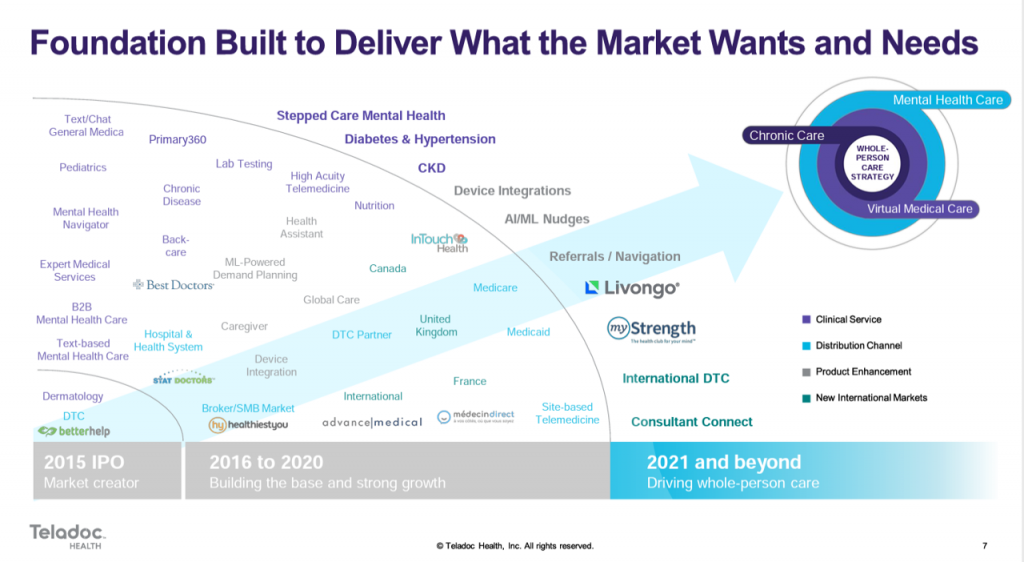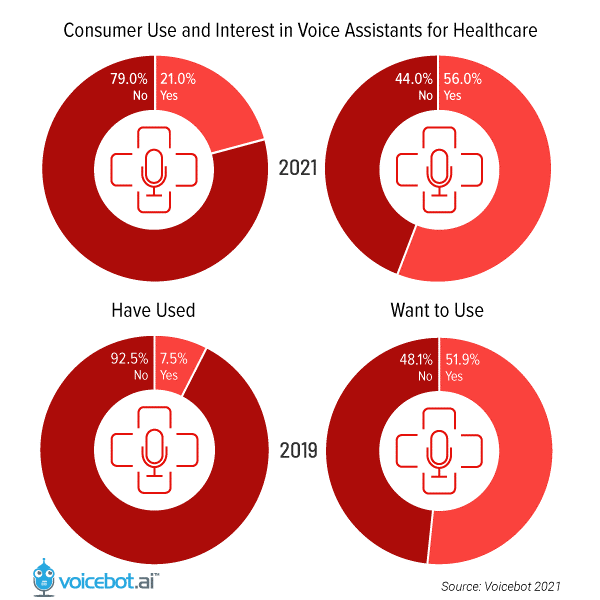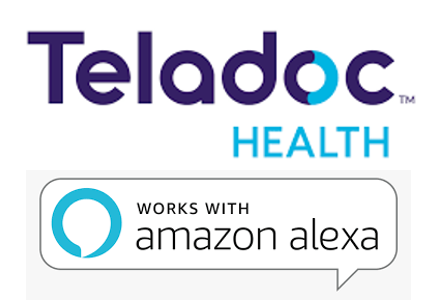Voice technology has become a mainstream household Internet of Things thing for consumers, used to streamline and ease peoples’ daily tasks to hear about the weather, listen to favorite tunes, or seek information.
 At the same time, the pandemic fostered growing experience with and appreciation for virtual care platforms and on-ramps to health care when needed. Patients have come to accept telehealth in their health care workflows when they value virtual care’s virtues: convenience, access, availability among other features.
At the same time, the pandemic fostered growing experience with and appreciation for virtual care platforms and on-ramps to health care when needed. Patients have come to accept telehealth in their health care workflows when they value virtual care’s virtues: convenience, access, availability among other features.
A leading provider of virtual care is Teladoc, whose most recent explanation of corporate strategy is shown in the first graphic from the company’s January 2022 investor deck.
Increasingly, voice tech will be used for health care tasks and workflows among both clinicians and providers as well as patients, caregivers, and consumers. In the convergence of voice and health, Teladoc announced a collaboration with Alexa, discussed in this press release.
Imagine this announcement now in that outer ring, up and to the right, in this “foundation built to deliver what the market wants.”
The official description of the program is,
“The launch of voice-activated general medical virtual care on supported Echo devices, such as an Echo, Echo Dot, and Echo Show. Customers in the U.S. will now be able to connect with a Teladoc care provider 24/7 from supported Echo devices for general medical needs. Teladoc on Alexa will initially launch via audio with video visits coming soon.”
Based on the Teladoc PR, the process begins with a consumer waking her Amazon voice assistant saying, “Alexa, I want to talk to a doctor.”
The patient is then connected to the Teladoc call center, and a virtual visit follow up for a non-emergency visit like suspected flu or allergy. The cost will range from $0/”free covered by health insurance or $75 cash out-of-pocket for people lacking insurance.
The telehealth encounter will be audio-only in this initial phase, and could evolve to include video-based encounters.
Interestingly, in its assessment of Amazon’s growing strategy and footprint in health care, The Street remarked that,
“In what could be seen as a blow to Teladoc, Amazon has rolled out the virtual part of Amazon Care nationwide. It has also expanded its in-person services to 20 more American cities in addition to Seattle, Baltimore, Boston, Dallas, Austin, Los Angeles, Washington, D.C., and Arlington where it already operates. The new markets include San Francisco, Miami, Chicago, and New York City.”
In the company’s collaboration with the health-ambitious eCommerce behemoth, Teladoc limits the risk exposure about which The Street s assessment warned just a few weeks ago.
 Health Populi’s Hot Points: With this alliance, Teladoc is responding to a growing number of health consumers’ interest in using voice technology for health care.
Health Populi’s Hot Points: With this alliance, Teladoc is responding to a growing number of health consumers’ interest in using voice technology for health care.
Voicebot.ai has been tracking this phenomenon for a few years, and here is their latest read on U.S. consumers’ demand for voice assistants’ support in health care.
Note that in 2019, 7.5% of people had used a voice assistant for their health, rising to 21.0% in 2021.
Furthermore, interest among people wanting to use voice tech in their health care rose from 51.9% in 2019 to 56.0% in 2021.
Demand for voice tech among health consumers outstrips supply, the Voicebot research revealed, based on the company’s read of their data.
To further demonstrate consumers’ growing interest in voice tech in managing their health and wellness, you can check out my lens on Voicebot’s previous study on the topic here in Health Populi.
And do add this into your growing understanding of consumers’ growing embrace of retail health and our homes as personal and family health hubs.





 I'm in amazing company here with other #digitalhealth innovators, thinkers and doers. Thank you to Cristian Cortez Fernandez and Zallud for this recognition; I'm grateful.
I'm in amazing company here with other #digitalhealth innovators, thinkers and doers. Thank you to Cristian Cortez Fernandez and Zallud for this recognition; I'm grateful. Jane was named as a member of the AHIP 2024 Advisory Board, joining some valued colleagues to prepare for the challenges and opportunities facing health plans, systems, and other industry stakeholders.
Jane was named as a member of the AHIP 2024 Advisory Board, joining some valued colleagues to prepare for the challenges and opportunities facing health plans, systems, and other industry stakeholders.  Join Jane at AHIP's annual meeting in Las Vegas: I'll be speaking, moderating a panel, and providing thought leadership on health consumers and bolstering equity, empowerment, and self-care.
Join Jane at AHIP's annual meeting in Las Vegas: I'll be speaking, moderating a panel, and providing thought leadership on health consumers and bolstering equity, empowerment, and self-care.